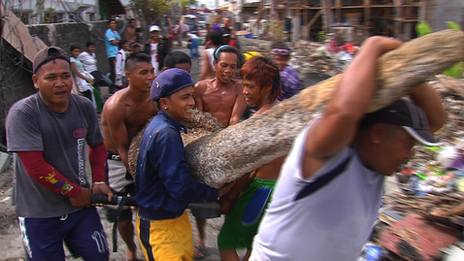Optimism as Tacloban faces rebuilding challenge
- Published
Jon Donnison "All across Tacloban people are doing their best to rebuild their lives"
For a city that has suffered so much, one of the most striking things amid the devastation in Tacloban is just how many people greet you with a smile.
One month after Typhoon Haiyan blasted through the Philippines and flattened this city, its residents have much to complain about.
But Filipinos, it seems, are not ones for whinging.
"We have to keep smiling. It gives us positive vibes," 21-year-old Zyrene Tomada tells me as she sits amid the wreckage of what's left of her home.
Three members of Zyrene's family were killed in the typhoon, but with her one-year old son Clyde sleeping peacefully beside her, she is trying to look forward not back.

Zyrene Tomada wants to look to the future
"We're very lucky God has given us a second chance to live. That's a good gift for this coming Christmas," she smiles even as she struggles to hold back the tears.
Self-help
And life is slowly being breathed back into this city.
There is a massive foreign aid operation underway here.
But much of the work is being done by the people themselves.
Everywhere you go young and old can be seen shovelling and sweeping through the endless piles of debris.
Thousands have signed up for what are called "cash for work" programmes where aid agencies pay people a few dollars a day to join the clean up.

"Cash for work" programmes clean up the city and give people some income
"One of the critical issues is putting money in peoples pockets," says Patrick Fuller from the International Federation of Red Cross and Red Crescent societies.
He says close to five million people in the Philippines have lost their livelihoods.
"They've got no place to go to work. They've got no form of income. So we're shifting from giving people food aid to giving people cash enabling them to spend money on what they need."
Back to business
And the impact is beginning to be seen at the city's main market.
In the immediate aftermath of the typhoon shops and warehouses were being ransacked with people desperate to get hold of any food they could.
A month on, there's legitimate trade going on and the market stalls are busy even though locals say prices are twice as high as before the typhoon.
Tacloban is slowly getting back to business.
.jpg)
Market stalls are trading again, but prices have doubled
"It's hard work," says Aiza Chavero who has a small stand selling chickens.
She says she now has to travel long distances to import the goods from other towns and cities but like many here she's resilient.
"You can survive this through prayers. You can fight for your business. For your work. Just to survive," she says.
Aiza says the small amount of money she earns means she can buy medicines for her sick father and not be so dependent on food aid.
'We can stand alone. We can stand for ourselves."
But in truth, most people in Tacloban are going to need help for a very long time.
There have been some successes. Aid agencies are happy that so far a major outbreak of disease has been avoided.

Aiza Chavero strives to be self-sufficient
Rebuilding effort
But the biggest issue remains shelter.
The United Nations estimates more than a million homes were damaged or destroyed across the Philippines.
More than three million people have been displaced.
The scale of the destruction means rebuilding is going to take years not months.
And while Tacloban has been the focus for the relief operation, aid agencies say there are many more remote areas where people are still struggling to get the help they need.
And all the while the death toll is still rising.
On a hillside outside Tacloban a mass grave, one of several, lies open and uncovered.
The corpses, a hundred or so, have been festering for weeks. The stench is overwhelming.
And one month after Typhoon Haiyan, there are still over 1,500 people missing
Every day more bodies are being recovered from under the wreckage.